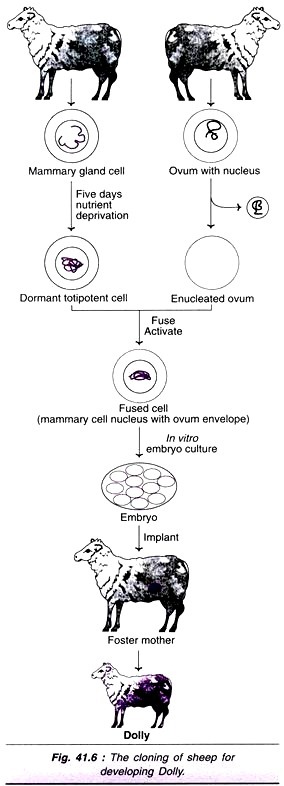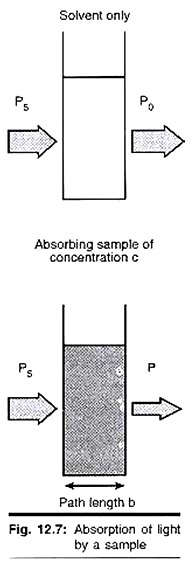The below mentioned article provides a short note on the Conversion of Fibrinogen to Fibrin by Thrombin.
Fibrinogen is a soluble plasma glycoprotein whose length is 46 nm. Its molecular weight is 340,000 and it consists of 6 polypeptide chains synthesized in liver. The 6 chains are two Aα chains, two Bβ chains, and two y chains making the structure Aα2 Bβ2 γ2. All three genes (Aα, Bβ and γ) are genetically linked.
The ends of the fibre-shaped fibrinogen molecule are highly negatively charged. These negatively charged termini of the fibrinogen molecules contribute to its water solubility and also repulse the termini of other fibrinogen molecule, for which aggregation is prevented.
The molecular weight of Thrombin is 34,000 and it consists of two polypeptide chains and hydrolyses four peptide bonds in fibrinogen. Removal of A and B portions of the fibrinogen molecule releases the negatively charged fibrinopeptides and generates the fibrin monomer.
The long insoluble fibrin monomers form the insoluble fibrin polymer clot-which traps red cells, platelets, and other components to form the red thrombus or the white thrombus (platelet plug). The initial fibrin clot is weak and held together only by fibrin monomers.
Thrombin also converts factors XIII to active factor XIII (XHIa) which is a transglutaminase. The transglutaminase covalently cross-links fibrin monomers. Persons with an inherited deficiency of factor XIII have a bleeding tendency due to unstable fibrin clot.
Prothrombin is a single chain glycoprotein with a molecular weight of 72,000. It is activated on the platelet and its activation requires platelet anionic, phospholipid, Ca++, factor Va, and factor Xa. The phospholipids bind Ca++ and prothrombin.
The platelets also contain factor V and is activated as Va which binds to specific receptors in the platelet membrane. Factor Va also acts as a receptor for factor Xa which in turn binds prothrombin. Factor Xa is a serine protease and cleaves the catalytically inactive prothrombin and the amino portion of prothrombin is released.
Factor Va, generated by thrombin, is subsequently inactivated by thrombin providing a means of limiting the activation of prothrombin to thrombin.
Activation of factor Xa:
1. Activation of factor Xa takes place at the conceptual site where the intrinsic and extrinsic pathways join to form the final common pathway.
2. Factor X is a zymogen having molecular weight of 55,000 of a serine protease and contains Gla residues.
3. The Gla residues of factor X are responsible for the calcium mediated binding of factor X to the acidic phospholipids of platelet membranes.
The extrinsic pathway for generating factor Xa:
1. The extrinsic pathway is very rapid in response to tissue injury.
2. Factor VII is the precursor of factor Vila and it is the Gla-containg glycoprotein synthesized in the liver. It can also be cleaved by thrombin or factor Xa. It is a zymogen and has high endogenous activity.
3. The tissue factor necessary to accelerate the attack of factor VII or Vila on factor X is abundant in placenta, lung, and brain.
4. There is only 0.01 mg of factor X per ml of plasma. This requires the amplification provided by the clotting system, conversion of factor X to Xa is an autocatalytic process and, therefore, an amplification system.
The intrinsic pathway for generating factor Xa:
1. The intrinsic pathway of the generation of Xa starts with the exposure of pre-kallikrein, high molecular-weight kininogen, factor XII, and factor XI to an activating surface.
2. Factor Xlla is generated by kallikrein and attacks pre-kallikrein to generate more kallikrein, setting up a reciprocal activation. It releases bradykinin from high molecular-weight kininogen and activated factor XI to XIa.
3. Factor IX, a Gla-containing zymogen, is activated in a two-step reaction by factor XIa.
4. Factor IXa slowly activates factor X by clearing the same Arg-IIe bond that factor Vila of the extrinsic system hydrolyzes in the presence of calcium and acid phospholipids. The factor IXa-catalyzed activation of factor X is accelerated about 500-fold by the presence of factor VIII or VIIIa.
5. Factor VIII requires activation by minute quantities of thrombin to form factor Villa.
6. The intrinsic pathway is slow because it involves many factors operating in a cascade mechanism to generate factor Xa.


